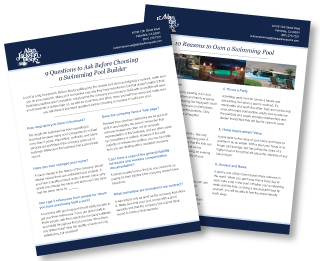Pool structures require a professional hand, as they must bear the brunt of both the outside ground weight and the inside water weight. Depending on the efficacy of the design, it may or may not have an impact on the concrete. Detailed instructions for building a pool that meets all the necessary standards are provided in this article to help you better understand this process. While regional norms may differ somewhat, they all adhere to the same basic principles and basic safety standards.
The Steps Involved in Building a Concrete Pool
As was previously noted, local building codes must be taken into account while designing poolside walls. Once the pool’s blueprints are finalized, building may begin.
During the pool building process you can expect the following:
1. The Place and Layout Selection Process
The first thing that has to be done before a pool can be built is a design. Choose a layout that works with the available space, or choose a piece of land that can expand to fit your desired layout. The layout of a swimming pool is determined by factors such as its shape, depth, surface area, filtering system, and overall dimensions.
The site you decide on for the pool should be conducive to easy upkeep. Flat terrain is preferable because it can greatly reduce the expense of the digging and filling phases. Pools clogged with dead leaves can be avoided by locating on land far from trees. The swimming pool should be built with its shady side facing the sun for optimal performance.
2. Putting Together the Foundation of the Pool
A pool’s lifetime is mostly controlled by its foundation. The excavation is leveled. Loose dirt must be replaced with hard, compacted soil. Compaction might employ naturally compacted soil or gravel. Use 12-40mm aggregates to compress and prepare the foundation. After compacting the base, it must conform to the terrain. The area to be compacted determines the equipment employed. When the pool’s foundation is crushed, cleaning concrete is poured. Concrete layer thickness is 5 cm.
The pool’s base should be slanted so water may flow into the filtration system. The incline must not upset the swimmers’ balance. Pools for kids and those who can’t swim should be 1 in 40. 1 out of 80 is required to empty efficiently (As per British and Euro Codes).
3. The Benefits of a Reinforced Steel Cage
After the pool’s walls have been excavated and the foundation has been prepared, the next stage is to strengthen the walls and floor with steel. In this case, the swimming pools interior is reinforced with a single steel cage using the shotcrete method. There is no separation between the walls and the floor in a uniting or shotcrete construction.
After the cage structure has been strengthened with steel, the necessary plumbing lines, drainage lines, etc. may be installed within. Side stairways are included as planned.
4. Swimming Pool Filter And Pump System
The filter and pump are installed on top of a big tank (made of concrete, metal, etc.). The plumb lines that will carry water from the pool to the filtration system and back to the pool must be installed prior to the concrete being poured.
The pool’s filter and pump are hardwired to the public water supply, ensuring a constant supply of clean water. This setup is essential for replenishing the pool’s water supply once it is used up by splashing or evaporation.
5. Concrete Work for A Swimming Pool
Apply a regular mix of concrete by concreting (or uniting) the walls and floors. Take use of specialized equipment to mold the surface to specifications. The concrete has to be cured after completing twice a day for 14 days.
6. Sealing The Concrete Pool to Prevent Leaks
Most concrete pools are waterproofed using tiles, glass, ceramic, epoxy-cement, or a membrane. The waterproofing technique is determined by the water table level and soil moisture. Walls and flooring are waterproofed.
7. Coping Construction
The coping surrounding a pool is the space for people to stroll. Concrete, marble, tile, or stone are all viable materials. Two or three days should elapse between coping installation and water fill-in.
We at Alan Jackson Pools would be happy to help you with your pool construction needs by creating the best possible design for your space. Contact us today for more information.


